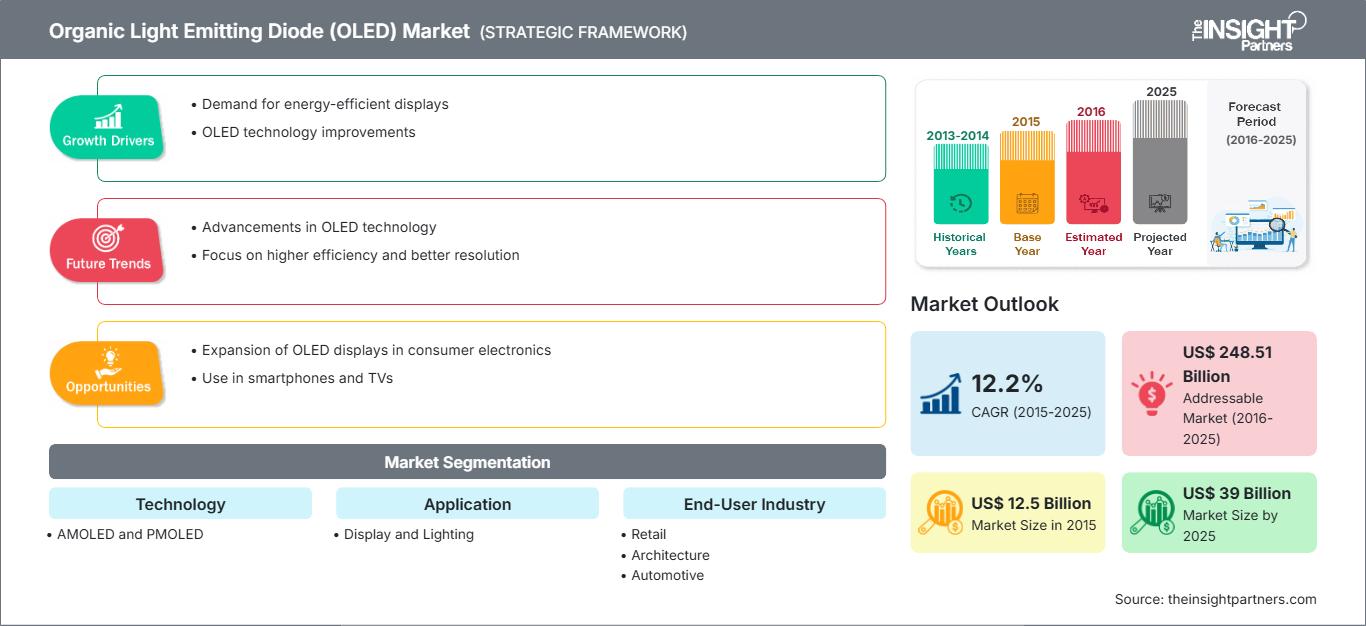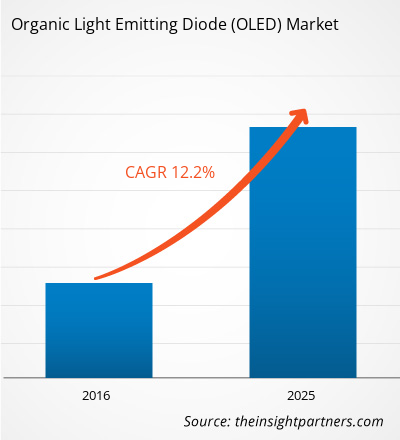Il mercato dei diodi organici a emissione di luce (OLED) è stato valutato a 12,5 miliardi di dollari nel 2015 e si prevede che raggiungerà i 39 miliardi di dollari nel 2025; si prevede una crescita a un CAGR del 12,2% dal 2015 al 2025.
Gli OLED sono costituiti da polimeri che emettono luce quando viene applicata una corrente. Gli OLED trovano impiego in diverse applicazioni, tra cui la vendita al dettaglio, la sicurezza, l'automotive, l'architettura e altre ancora. La tecnologia OLED è utilizzata in un'ampia gamma di dispositivi elettronici di consumo, tra cui display per telefoni cellulari, cuffie Bluetooth, display audio per auto, console di gioco portatili, lettori MP3, fotocamere digitali e in molte altre applicazioni industriali. I due principali settori di applicazione degli OLED sono l'illuminazione e i display. Attualmente, le tre zone con maggiori sforzi di sviluppo negli OLED flessibili sono l'Asia orientale, l'Europa e il Nord America.
Il mercato dei diodi organici a emissione di luce (OLED) è in costante crescita e si stanno effettuando significativi investimenti di capitale per promuovere prodotti a prezzi competitivi nei prossimi anni. I display OLED disponibili oggi sul mercato sono ancora costosi, ma con il progresso tecnologico si prevede che i prezzi diminuiranno. Gli attuali progressi nelle prestazioni dei display hanno portato a una maggiore competitività dei prodotti e si prevede che la domanda di display più piccoli, in particolare per gli smartphone, crescerà a un ritmo immediato. Mentre, per il mercato dei display di grandi dimensioni, si prevede una crescita della domanda di televisori piatti con display OLED nel prossimo futuro.
Il mercato OLED è suddiviso geograficamente in Nord America, Europa, APAC, Sud America e Medio Oriente. La produzione di display a risparmio energetico, che includono tecnologie ecosostenibili, sta trainando la crescita del mercato OLED in quasi tutte le regioni. Con una maggiore consapevolezza pubblica per i prodotti ecocompatibili, aziende come Sony, Apple, Philips e Samsung stanno migliorando l'efficacia dei display con OLED. Consapevoli del fatto che gli schermi LCD e al plasma consumano più energia, i produttori stanno anche sviluppando display OLED che consumano meno energia e offrono flessibilità. L'attuale scenario del mercato globale degli OLED mostra che l'area Asia-Pacifico (APAC) sta dominando il mercato, seguita dal Nord America. Due delle principali aziende produttrici di display OLED, LG Display e Samsung Display, sono concentrate principalmente in Corea del Sud, ed entrambe le aziende si concentrano costantemente sull'aumento della loro capacità produttiva e sulla produzione di pannelli OLED di grandi dimensioni. Oltre alle aziende sopra menzionate, la maggior parte delle aziende produttrici di display OLED è presente nell'area Asia-Pacifico, in particolare a Taiwan e in Cina, e sta investendo intensamente nella ricerca e sviluppo dei pannelli OLED con l'obiettivo di aumentare la produttività riducendo i costi di produzione. Si prevede che la crescita aumenterà nel periodo previsto, con l'emergere di nuove aziende che investono nel settore della produzione di OLED e i più recenti progressi in atto per lo sviluppo della tecnologia OLED.
Approfondimenti di mercato: crescente adozione di micro-display in vari settori verticali
La tecnologia dei display è diventata onnipresente nella nostra vita quotidiana. Un micro-display è un display estremamente piccolo, che misura meno di 25 mm in diagonale. Queste unità di visualizzazione sono dotate di schermi ad alta risoluzione e alta densità, utilizzati da unità di visualizzazione ingrandite. I micro-display sono stati introdotti circa due decenni fa. I micro-display sono implementati in vari settori verticali, come quello industriale, commerciale, aerospaziale, militare, automobilistico, medico, delle forze dell'ordine e del soccorso. I micro-display sono principalmente utilizzati negli HMD e negli HUD per uso militare e aerospaziale. Micro-OLED è stata l'azienda pioniera nell'offrire micro-display basati su OLED ai settori militare e aerospaziale. Questi display migliorano la risoluzione delle immagini e consumano meno energia.
Approfondimenti di mercato basati sulla tipologia
I diodi organici a emissione di luce (OLED) producono luce quando vengono alterati con corrente elettrica. Questi dispositivi sono costituiti principalmente da polimeri e altre piccole molecole di natura organica e promettono molteplici applicazioni nei display piatti, sostituendo la tecnologia obsoleta dei tubi a raggi catodici (CRT). Il mercato globale degli OLED è stato suddiviso principalmente in due categorie: diodi organici a emissione di luce a matrice passiva (PMOLED) e diodi organici a emissione di luce a matrice attiva (AMOLED).
Approfondimenti di mercato basati sull'applicazione
Il mercato globale dei diodi organici a emissione di luce, in base all'applicazione, è stato segmentato in display OLED e illuminazione OLED. Gli OLED sono utilizzati per produrre display digitali in dispositivi come schermi TV, monitor per computer e dispositivi portatili come console di gioco portatili, telefoni cellulari e PDA. Un display OLED è in grado di visualizzare livelli di nero profondi ed è più leggero e sottile rispetto a un LCD, poiché non ha retroilluminazione. Le luci OLED sono composte da materiale semiconduttore stratificato tra due elettrodi. L'OLED è una combinazione di sottili strati di pellicola verde, blu e rossa per rilasciare una luce bianca più morbida.
Approfondimenti di mercato basati sull'utente finale
La flessibilità degli OLED consente ai produttori di creare OLED utilizzando processi di produzione reel-to-reel e consente la produzione di prodotti di illuminazione e display flessibili. Gli OLED sono commercialmente realizzati su substrati di vetro rigidi. Tuttavia, applicazioni come display curvi o orologi con OLED flessibili sono recentemente entrate nel mercato. Sono necessari ulteriori sviluppi di processi e strumenti di produzione e materiali migliori per lo sviluppo di OLED sufficientemente flessibili e durevoli. Il mercato globale degli OLED è segmentato in base ai settori verticali dell'utente finale: illuminazione per la vendita al dettaglio, sicurezza e segnaletica, automotive, prodotti di consumo, architettura e altri (industriale, alimentare, medico ecc.).
Personalizza questo rapporto in base alle tue esigenze
Potrai personalizzare gratuitamente qualsiasi rapporto, comprese parti di questo rapporto, o analisi a livello di paese, pacchetto dati Excel, oltre a usufruire di grandi offerte e sconti per start-up e università
Mercato dei diodi organici a emissione di luce (OLED): Approfondimenti strategici

- Ottieni le principali tendenze chiave del mercato di questo rapporto.Questo campione GRATUITO includerà l'analisi dei dati, che vanno dalle tendenze di mercato alle stime e alle previsioni.
Potrai personalizzare gratuitamente qualsiasi rapporto, comprese parti di questo rapporto, o analisi a livello di paese, pacchetto dati Excel, oltre a usufruire di grandi offerte e sconti per start-up e università
Mercato dei diodi organici a emissione di luce (OLED): Approfondimenti strategici

- Ottieni le principali tendenze chiave del mercato di questo rapporto.Questo campione GRATUITO includerà l'analisi dei dati, che vanno dalle tendenze di mercato alle stime e alle previsioni.
Lo sviluppo del prodotto è la strategia comunemente adottata dalle aziende per espandere il proprio portafoglio prodotti. Osram, OLEDWORKS, LG e Acuity Brands, tra gli altri, sono i principali attori che implementano strategie per ampliare la base clienti e acquisire una quota significativa nel mercato globale dei diodi organici a emissione di luce (OLED), il che a sua volta consente loro di mantenere il proprio marchio. Alcuni dei recenti sviluppi chiave sono:
- Nel 2014, Futaba Corporation ha annunciato un'alleanza finanziaria e commerciale con SANKO GOSEI LTD, produttore e venditore di stampi per stampaggio e prodotti in plastica stampata. Ciò faciliterà l'azienda nello sviluppo di nuovi prodotti e tecnologie, nell'aumento degli ordini e nello sfruttamento del mercato, nella condivisione di strutture e nella condivisione di pratiche di gestione e produzione.
- Nel febbraio 2016, Samsung ha annunciato che l'azienda sta sviluppando pannelli TV OLED investendo circa 3 miliardi di dollari nella produzione di TV OLED.
Approfondimenti regionali sul mercato dei diodi organici a emissione di luce (OLED)
Le tendenze regionali e i fattori che influenzano il mercato dei diodi organici a emissione di luce (OLED) durante il periodo di previsione sono stati ampiamente spiegati dagli analisti di The Insight Partners. Questa sezione illustra anche i segmenti e la geografia del mercato dei diodi organici a emissione di luce (OLED) in Nord America, Europa, Asia-Pacifico, Medio Oriente e Africa, America meridionale e centrale.
Ambito del rapporto di mercato sui diodi organici a emissione di luce (OLED)
| Attributo del rapporto | Dettagli |
|---|---|
| Dimensioni del mercato in 2015 | US$ 12.5 Billion |
| Dimensioni del mercato per 2025 | US$ 39 Billion |
| CAGR globale (2015 - 2025) | 12.2% |
| Dati storici | 2013-2014 |
| Periodo di previsione | 2016-2025 |
| Segmenti coperti |
By Tecnologia
|
| Regioni e paesi coperti | Nord America
|
| Leader di mercato e profili aziendali chiave |
|
Densità degli operatori del mercato dei diodi organici a emissione di luce (OLED): comprendere il suo impatto sulle dinamiche aziendali
Il mercato dei diodi organici a emissione di luce (OLED) è in rapida crescita, trainato dalla crescente domanda degli utenti finali, dovuta a fattori quali l'evoluzione delle preferenze dei consumatori, i progressi tecnologici e una maggiore consapevolezza dei vantaggi del prodotto. Con l'aumento della domanda, le aziende stanno ampliando la propria offerta, innovando per soddisfare le esigenze dei consumatori e sfruttando le tendenze emergenti, alimentando ulteriormente la crescita del mercato.

- Ottieni il Mercato dei diodi organici a emissione di luce (OLED) Panoramica dei principali attori chiave
- Diodo organico a emissione di luce a matrice passiva (PMOLED)
- Diodo organico a emissione di luce a matrice attiva (AMOLED).
mercato dei diodi organici a emissione di luce (OLED) - Per applicazione
- Display OLED
- Illuminazione OLED
mercato dei diodi organici a emissione di luce (OLED) - Per utente finale
- Illuminazione per la vendita al dettaglio
- Sicurezza e Segnaletica
- Automotive
- Prodotti di consumo
- Architettura
- Altro
Mercato dei diodi organici a emissione di luce (OLED) - Profili aziendali
- LG Display
- Samsung Display Co., Ltd
- Futaba Corporation
- Universal Display Corporation
- RITEK Corporation
- OSRAM GmbH
- OLEDWorks LLC
- Innolux Corporation
- SEIKO EPSON CORPORATION
- Acuity Brands Lighting Inc.
- Koninklijke Philips NV
- Analisi storica (2 anni), anno base, previsione (7 anni) con CAGR
- Analisi PEST e SWOT
- Valore/volume delle dimensioni del mercato - Globale, Regionale, Nazionale
- Industria e panorama competitivo
- Set di dati Excel
Report recenti
Testimonianze
Motivo dell'acquisto
- Processo decisionale informato
- Comprensione delle dinamiche di mercato
- Analisi competitiva
- Analisi dei clienti
- Previsioni di mercato
- Mitigazione del rischio
- Pianificazione strategica
- Giustificazione degli investimenti
- Identificazione dei mercati emergenti
- Miglioramento delle strategie di marketing
- Aumento dell'efficienza operativa
- Allineamento alle tendenze normative




















 Ottieni un campione gratuito per - Mercato dei diodi organici a emissione di luce (OLED)
Ottieni un campione gratuito per - Mercato dei diodi organici a emissione di luce (OLED)